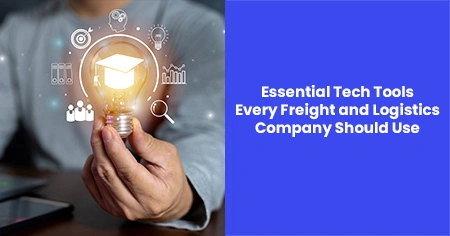This fast-evolving sector is on a strong growth trajectory. According to GlobeNewswire, its value is expected to rise from $6.23 trillion in 2024 to an impressive $8.98 trillion by 2031. This projected growth, marked by a robust CAGR of 4.81%, highlights the increasing demand for efficiency, agility, and precision across all facets of freight and logistics operations.Along with operational efficiency, managing potential risks has become equally vital for sustainability in this high-stakes environment. Tools that support risk management in logistics and transport are playing a critical role in helping businesses stay compliant, minimize losses, and ensure safety across the board
To thrive in this competitive landscape, embracing cutting-edge technology is no longer optional but essential.
This article highlights key tech tools that smart freight and logistics companies can use to streamline and enhance overall performance.
Transportation Management Systems (TMS)
As the backbone of efficient transportation, TMS platforms go beyond basic routing and scheduling. According to Gartner, TMS software supports multimodal planning and execution, helping shippers manage varying transportation complexities across different modes and regions.
Modern TMS solutions also provide:
- Route optimization algorithms that consider multiple variables, including traffic patterns and delivery windows, to create the most efficient delivery sequences
- Automated documentation generation for bills of lading, proof of delivery, and customs documentation
- Analytics capabilities that identify trends, bottlenecks, and opportunities for operational improvements
- Integration capabilities with other systems, including warehouse management, accounting, and customer relationship management platforms
- Looking to estimate your shipping costs with precision? Try our Amazon Freight Calculator for quick, accurate freight quotes.
Warehouse Management Systems (WMS)
WMS provides the technological framework needed to optimize internal operations.
Key features include:
- Inventory tracking and management using barcoding or RFID technology to maintain real-time inventory accuracy rates exceeding 99%
- Pick-path optimization that reduces unnecessary movement and accelerates order fulfillment
- Labor management tools that track productivity, identify training needs, and optimize workforce allocation
- Space utilization planning to maximize storage capacity and organize products according to movement velocity
- Cross-docking capabilities to minimize storage requirements for fast-moving inventory
In recent years, the integration of artificial intelligence (AI) has transformed WMS, enhancing visibility, accuracy, and speed in fulfillment operations. AI aids in optimizing product placement, picking patterns, and robotics management. It also helps businesses improve demand forecasting, adjust to market changes, and manage inventory levels more effectively.
Telematics and Fleet Management
The vehicles themselves represent both significant capital investments and ongoing operational costs for logistics companies. Advanced telematics and fleet management tools provide crucial visibility and control over these mobile assets. Some providers, like Pro-Vision solutions, offer fleet-focused technologies such as video systems, body-worn cameras, and cloud-based evidence management tools that support both safety and regulatory requirements.
Key features include:
- GPS tracking and geofencing that provide real-time location data and automated alerts when vehicles deviate from planned routes
- Engine diagnostics that monitor vehicle health and predict maintenance needs before failures occur
- Fuel consumption monitoring to identify inefficient driving practices or potential mechanical issues
- Driver performance metrics, including hard braking, rapid acceleration, and extended idling, that impact both fuel economy and vehicle wear
- Electronic logging devices that automate hours-of-service compliance and eliminate paper logbooks
Markets.Us projects the global vehicle telematics market will reach USD 159.3 billion by 2033, with a steady CAGR of 9.0% starting in 2023. In that same year, embedded technology led the market with a commanding 67.3% share, favored for its dependability and advanced safety capabilities.
Safety Tech You Can’t Ignore
Accidents and collisions can be devastating for freight and logistics companies, leading to costly repairs, delayed deliveries, and even reputational damage. Advanced fleet accident management software is essential for accident prevention and safety management. Safety also extends to indoor work environments like warehouses and logistics hubs, where maintaining clean air is crucial. Installing industrial air cleaning systems helps reduce airborne pollutants, improving employee health, reducing absenteeism, and enhancing overall operational safety.
Key features include:
- Onboard dash cams: High-definition, front- and rear-facing cameras provide a 360-degree view, capturing critical events and helping exonerate drivers from false claims.
- AI-driven driver alerts: AI technology detects dangerous driving habits like hard braking, rapid acceleration, and distracted driving.
- Data analytics and predictive insights: Fleet managers can analyze driver performance, identify high-risk behaviors, and implement customized coaching programs.
- Routine maintenance scheduling: Proactive maintenance tracking ensures vehicles are always roadworthy, preventing breakdowns that could lead to accidents.
- GPS fleet tracking: Real-time vehicle tracking allows for immediate response to emergencies and helps monitor compliance with safety protocols.
A tragic example highlights the importance of safety technology. In May last year, a crash involving a commercial vehicle resulted in the deaths of Michelle C. Yaeger and her two young daughters in St. Louis County.
Surviving family members are now pursuing legal action, emphasizing the importance of robust safety measures in preventing such tragic incidents. This also highlights the critical need for legal support, as a St. Louis truck accident lawyer can guide victims through the complex process of seeking justice.
According to TorHoerman Law, truck accidents typically cause more extensive harm than typical car accidents. As a result, victims often face long-term physical, emotional, and financial challenges.
Last-Mile Delivery Optimization
The final leg of delivery has become increasingly important as e-commerce growth drives consumer expectations for faster, more precise delivery windows. Last-mile optimization tools address this challenging segment.
Key features include:
- Dynamic routing algorithms that adjust in real-time to changing conditions, including traffic, weather, and new orders.
- Automated customer communications provide accurate delivery windows and proactive updates when delays occur.
- Proof-of-delivery systems with photo confirmation, electronic signatures, and GPS coordinates.
- Delivery exception management that quickly identifies failed delivery attempts and initiates resolution workflows.
- Crowdsourced delivery options that tap into gig economy workers during peak demand periods.
Frequently Asked Questions
How can smaller logistics companies with limited budgets approach technology implementation?
Smaller logistics companies can start by prioritizing cost-effective, scalable solutions like cloud-based TMS or WMS platforms. Leveraging free trials, open-source tools, and phased rollouts allows gradual adoption. Partnering with tech vendors offering flexible pricing and focusing on high-impact areas like tracking or inventory management can maximize value.
What integration challenges should companies anticipate when implementing these various technology solutions?
Data compatibility represents the most significant integration challenge, as different systems may use varying formats, protocols, and definitions for similar information. Before implementation, develop a clear data governance strategy defining how information will be structured, shared, and maintained across platforms.
How can logistics companies measure the ROI of their technology investments?
Establish clear baseline metrics before implementation to enable accurate before-and-after comparisons. Focus measurement on specific KPIs directly impacted by each technology. For TMS, measure transportation cost per unit, on-time delivery percentage, and planning labor hours. For safety technology, track accident frequency, insurance premiums, and claims costs.








